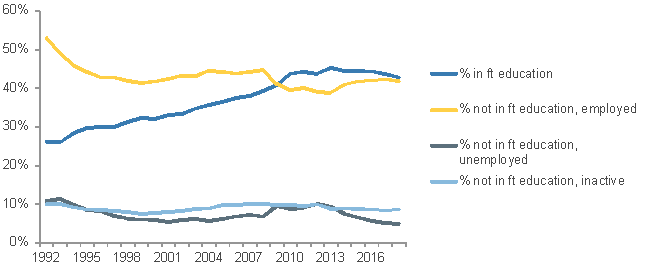Young people still struggle to thrive in today's labour market
12 Jul 2018
Jim Hillage, Director of Employment Policy Research
Over the past fifty years the Institute has monitored the state of the youth labour market which, during that time, has changed more dramatically than almost any other aspect of UK employment.
World Youth Skills Day on 15 July is about emphasising the importance of technical and vocational education, whilst recognising the need to train and develop young people to acquire marketable skills. You might think that this isn’t of particular relevance to the modern UK labour market, with its record levels of employment. Yet, despite relatively low unemployment, young people in the UK find it much harder now than in the past to find jobs and establish themselves in the labour market.
Currently, unemployment rates (the proportion of people who are economically active) for people aged 16 to 24 not in full-time education is 10.5 per cent (June 2018 ONS data), over three times higher than the 3.3 per cent rate for 25 to 64 year olds (Annual Population Survey, January – December 2017). Youth unemployment is traditionally higher than adult unemployment but this gap has risen from around one and half times as high in the early 1990s. Now, more than they used to, young people find it much more difficult to establish themselves in the labour market.
Looking back to 1992 (see Figure 1 below) we can see that at the beginning of the 1990s, over 50 per cent of all young people, including those who are economically inactive, were in employment and only about a quarter in full-time education. The rest were either unemployed or economically inactive. By 2009, the proportion in employment had fallen, as unemployment rose in the recession, and the share in education rose to the same level, at around 40 per cent. Thereafter the proportion in education has exceeded those in employment, although as unemployment has fallen the gap has narrowed.
There are a number of reasons behind these changes, including:
-
Structural changes in the education leaving age: with rises from 15 to 16 in 1972 and more recently in 2013 when it became compulsory for young people to stay in some form of education, training or employment until the age of 18.
-
Dramatic increases in the number of young people entering higher education. The number of students obtaining a first degree in 1970 was 50,000, a fraction of the 400,000 plus graduates in 2017.
-
Changing recruitment practices among employers who now rarely recruit 16 to 18 year olds in large numbers direct from schools and colleges preferring older workers with more experience or skills.
Figure 1: Economic activity among young people aged 16 to 24, 1992 to 2018

Source: Office for National Statistics
While a large proportion of young people defer labour market entry until after higher education, and generally do better in employment as a result, many still try to find a job on leaving full-time education.
Research at the Institute has demonstrated how not finding a job when young and becoming unemployed can have a detrimental effect on subsequent life chances – the so-called underlined the importance of young people gaining labour market experience during their education and acquiring vocational skills. Both are associated with a more successful labour market entry, reduced unemployment for young people and also improved labour market success in later life. It is therefore welcome that the government is committing to introducing T-Levels, the new technical study programmes that will sit alongside apprenticeships within a reformed skills training system, which IES research is playing a key role in evaluating. Hopefully they will have more of an impact on young people’s employment chances than apprenticeships themselves. Back in the 1960s, when the Institute was founded, over 110,000 school leavers entered apprenticeships. They then went into decline as vocational education was put on the policy back-burner. Despite a resurgence of interest in skills policy and recent growth in the number of apprenticeships, only 29,000 16 year olds and 41,000 17 year olds started an apprenticeship in 2016/17. Nearly half of the almost 500,000 starts involved people aged 25 or older. Apprenticeships are no longer primarily aimed at young people.
Let World Youth Skills Day serve as a reminder of how far the UK still has to go to be able to offer the full range of opportunities that young people need to develop the skills required to thrive in the modern labour market.
Any views expressed are those of the author and not necessarily those of the Institute as a whole.






